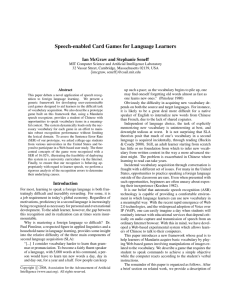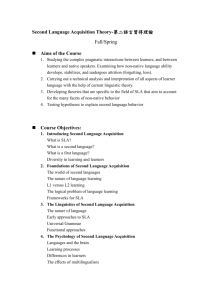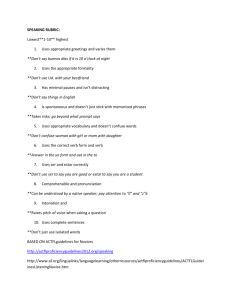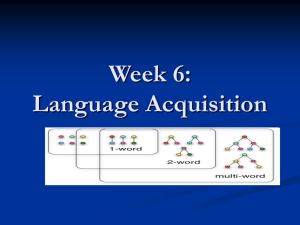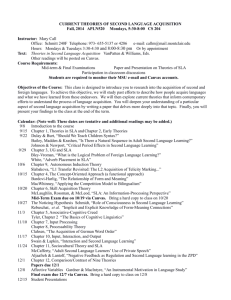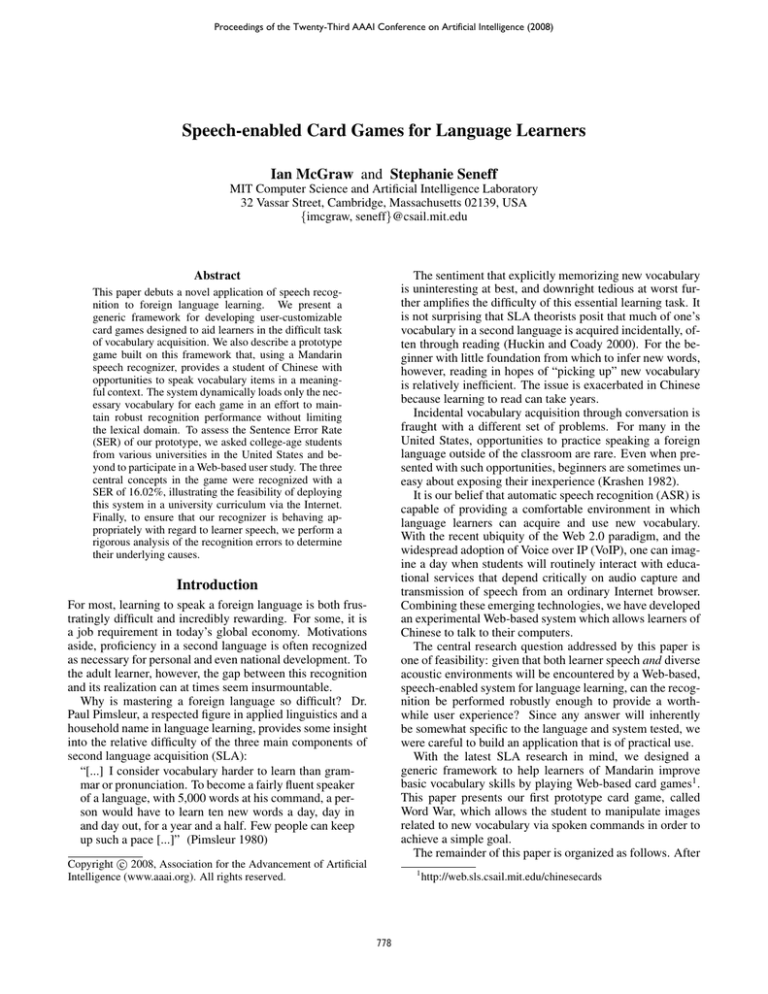
Proceedings of the Twenty-Third AAAI Conference on Artificial Intelligence (2008)
Speech-enabled Card Games for Language Learners
Ian McGraw and Stephanie Seneff
MIT Computer Science and Artificial Intelligence Laboratory
32 Vassar Street, Cambridge, Massachusetts 02139, USA
{imcgraw, seneff}@csail.mit.edu
Abstract
The sentiment that explicitly memorizing new vocabulary
is uninteresting at best, and downright tedious at worst further amplifies the difficulty of this essential learning task. It
is not surprising that SLA theorists posit that much of one’s
vocabulary in a second language is acquired incidentally, often through reading (Huckin and Coady 2000). For the beginner with little foundation from which to infer new words,
however, reading in hopes of “picking up” new vocabulary
is relatively inefficient. The issue is exacerbated in Chinese
because learning to read can take years.
Incidental vocabulary acquisition through conversation is
fraught with a different set of problems. For many in the
United States, opportunities to practice speaking a foreign
language outside of the classroom are rare. Even when presented with such opportunities, beginners are sometimes uneasy about exposing their inexperience (Krashen 1982).
It is our belief that automatic speech recognition (ASR) is
capable of providing a comfortable environment in which
language learners can acquire and use new vocabulary.
With the recent ubiquity of the Web 2.0 paradigm, and the
widespread adoption of Voice over IP (VoIP), one can imagine a day when students will routinely interact with educational services that depend critically on audio capture and
transmission of speech from an ordinary Internet browser.
Combining these emerging technologies, we have developed
an experimental Web-based system which allows learners of
Chinese to talk to their computers.
The central research question addressed by this paper is
one of feasibility: given that both learner speech and diverse
acoustic environments will be encountered by a Web-based,
speech-enabled system for language learning, can the recognition be performed robustly enough to provide a worthwhile user experience? Since any answer will inherently
be somewhat specific to the language and system tested, we
were careful to build an application that is of practical use.
With the latest SLA research in mind, we designed a
generic framework to help learners of Mandarin improve
basic vocabulary skills by playing Web-based card games1 .
This paper presents our first prototype card game, called
Word War, which allows the student to manipulate images
related to new vocabulary via spoken commands in order to
achieve a simple goal.
The remainder of this paper is organized as follows. After
This paper debuts a novel application of speech recognition to foreign language learning. We present a
generic framework for developing user-customizable
card games designed to aid learners in the difficult task
of vocabulary acquisition. We also describe a prototype
game built on this framework that, using a Mandarin
speech recognizer, provides a student of Chinese with
opportunities to speak vocabulary items in a meaningful context. The system dynamically loads only the necessary vocabulary for each game in an effort to maintain robust recognition performance without limiting
the lexical domain. To assess the Sentence Error Rate
(SER) of our prototype, we asked college-age students
from various universities in the United States and beyond to participate in a Web-based user study. The three
central concepts in the game were recognized with a
SER of 16.02%, illustrating the feasibility of deploying
this system in a university curriculum via the Internet.
Finally, to ensure that our recognizer is behaving appropriately with regard to learner speech, we perform a
rigorous analysis of the recognition errors to determine
their underlying causes.
Introduction
For most, learning to speak a foreign language is both frustratingly difficult and incredibly rewarding. For some, it is
a job requirement in today’s global economy. Motivations
aside, proficiency in a second language is often recognized
as necessary for personal and even national development. To
the adult learner, however, the gap between this recognition
and its realization can at times seem insurmountable.
Why is mastering a foreign language so difficult? Dr.
Paul Pimsleur, a respected figure in applied linguistics and a
household name in language learning, provides some insight
into the relative difficulty of the three main components of
second language acquisition (SLA):
“[...] I consider vocabulary harder to learn than grammar or pronunciation. To become a fairly fluent speaker
of a language, with 5,000 words at his command, a person would have to learn ten new words a day, day in
and day out, for a year and a half. Few people can keep
up such a pace [...]” (Pimsleur 1980)
c 2008, Association for the Advancement of Artificial
Copyright Intelligence (www.aaai.org). All rights reserved.
1
778
http://web.sls.csail.mit.edu/chinesecards
a brief section on related work, we provide a description of
our card creator and the online game. Our first experiments
in introducing this system to remote users are then recounted
in a long section on data collection, evaluation, and error
analysis. Finally, we provide a short summary and a look to
the future.
Related Research
Speech recognition as applied to SLA has recently enjoyed
increased attention in the research community (Gamper and
J.Knapp 2002). Prototype spoken dialogue systems, e.g.,
(Wik, Hjalmarson, and Brusk 2007; Raux and Eskenazi
2004), attempt to provide pedagogically grounded environments for language acquisition. Some effort has been put
into making these systems engaging: one system even provides a 3D video game interface (Johnson et al. 2004).
Developing full fledged dialogue systems for SLA is both
difficult and time consuming. To ensure a robust system, it is
often necessary to greatly restrict the domain (McGraw and
Seneff 2007). While research in such systems often produces promising prototypes, they rarely make it out of the
laboratory.
The work presented in this paper differs from previous
research in a number of respects. First, we adopt a Webbased model, and demonstrate ease of deployment by conducting a user study remotely. Furthermore, our framework
allows students and teachers to create their own content to
be loaded into our prototype game. While there do exist a
few recent examples of Web-based ASR systems for learning Chinese (Chengo Chinese 2004; Wang and Seneff 2007),
these systems do not specifically target vocabulary acquisition, nor do they offer the user the ability to personalize their
learning experience.
Figure 1: A single card created with our online tool.
if they so choose. There is no shortage of flash-card systems already available on the Web, and though they vary in
ease-of-use and number of features, few have grounding in
the rich field of SLA theory. Though highly customizable,
an attribute that would be lauded by proponents of learnercentered classrooms, flash-cards encourage students to take
words out of any meaningful context, not to mention their
inherent tediousness.
Another common failing of flash-cards is that they do not
require the user to speak. While some in the SLA theory
community would not regard this as a negative characteristic (Krashen 1994), many if not most SLA researchers agree
that spoken output is not simply the result of learning a foreign language, but an important component of its acquisition
(Swain 1985). A study consisting of activities very similar
to the game we are about to present was even able to show
advantages of spoken output towards the task of vocabulary
acquisition in particular (Ellis and He 1999).
Card Creator
Before describing the prototype card game on which we
based our user study, we briefly discuss an additional tool
that emphasizes the customizability of our framework. Using Web 2.0 technology, we have integrated an online Chinese language learning dictionary2 and Yahoo image search3
directly into a card creation web site.
With these tools, students and teachers can quickly build
entire categories of image-based cards and store them in our
database. A set of public categories is available, or users can
choose to sign up for a private account. Figure 1 shows an
example of a single card formed directly from a dictionary
entry and a Yahoo image search of the English word ‘frog’.
Note that students of Mandarin often use pinyin, a romanization of the Chinese characters, as a pronunciation guide.
This eases the task of producing a language model for the
recognizer, as we will describe later.
On its own, this web site is nothing more than a customizable flash-card database, albeit with a few helpful extra
search features built in. In fact, we do provide a flash-card
player that allows students to review vocabulary this way
2
3
Word War
The card creator’s primary function is to enable users to customize a card game such as Word War to their individual
language learning needs. Although this prototype game is
simple, it demonstrates well the methods by which more entertaining card games could be developed and used to teach
vocabulary in an interactive manner. In fact, the name “Word
War” is better suited to the multi-player mode of the game
which makes play far more interesting. We will not, however, be elaborating on multi-player mode in this paper.
In single-player mode, each game begins by loading a category of cards into the “game grid”. A small example of a
two-column game grid initialized with the “animals” category is depicted in Figure 2. Typically the game is played
on a grid with at least five columns. The goal of Word War
is to use voice commands to move the images in the bottom
two rows, subsequently referred to as source images, into
the slot directly underneath the matching target image on
the top row. Notice that when the cursor is over an image
a hint appears above the game grid telling the student the
pinyin pronunciation of the word.
There are three types of commands understood by our
http://www.xuezhongwen.net
http://images.search.yahoo.com
779
mation directly in the recognition stage would render the
system unusable for many non-native speakers, and instead
we infer the correct tones from the language model. Eventually we hope to include feedback on a user’s tones, but we
must do so in a manner that does not cripple usability for
beginners in Mandarin.
Once the recognizer and the Web-based interface are initialized, and the user is ready, he or she can speak by pressing and holding the large button above the game grid. Audio is then streamed from the user’s machine directly to our
recognizer, processed, and the results are passed along to a
game manager also residing on a server. Commands are then
extracted from these utterances and reactions are sent to the
client and executed in Java-script. The code infrastructure
that makes this possible is based on AJAX technology and
has been used in a number of unrelated projects in the Spoken Language System’s group, e.g., (Gruenstein and Seneff
2007).
In Word War, the visual reactions available to the browser
as a response to an utterance are highlighting one or more
source images and moving an image into the specified slot.
A feature of our system is that it provides constant visual
feedback in real time as the user is speaking. For example, a student can say “Select the cell phone and put it in
the third square.” Our system will carry out intermediate
responses (e.g., highlighting the cell phone) before the utterance is completed. Indeed, it is possible to string multiple
sentences together in such a manner that, even with a fivecolumn game grid, the adept student can place all five source
pictures into their proper locations without lifting the holdto-talk button.
A final feature of our system that deserves mention is the
play-back mode. During each student’s game, the system
maintains a log file of the interaction, and also captures all
their recorded utterances for later processing. Once a student
has completed an entire game, a teacher or researcher can
watch and listen to a replay of their session via the very same
game grid interface described above. This feature should
be quite valuable to teachers who might want to review a
student’s game. Play-back mode was also indispensable for
the system evaluation procedure described later.
There are a number of aspects of our system that are pleasing from a pedagogical perspective. The first is that we are
able to use images to avoid prompting the user in English.
Secondly, notice that it is impossible to both ask for a hint
and speak an utterance at the same time, since the user must
remove the mouse from its location over the image in order to press the record button. This intentional limitation
requires the user to memorize the pronunciation, if only for
a short time, and use it in a sentence that gives the word
a meaningful context. Lastly, the real-time visual feedback
makes it possible for the student to practice speaking fluently, while checking that they are being understood.
Figure 2: The two-column version of the card game. The
user can mouse-over an image to see the pronunciation hint.
system: select, drop, and shift. Each command type, subsequently referred to as a notion, can be instantiated with
vocabulary words, numbers, or right/left directions respectively to form an action which the system will interpret to
make a change on the game grid. The English equivalents
of a few actions are exemplified in the following three sentences: 1) Choose the frog. 2) Drop it into slot two. 3) Move
it one square to the left. The game is complete once all
of the source images have been appropriately aligned with
their targets. Note that a shift action is typically used for error corrections. For example, a recognition error in a drop
action might cause a source image to be placed under a nonmatching target image.
Each notion can be expressed a number of ways in Mandarin, so we maintain a context free grammar (CFG) that
captures many of them. When the game is loaded, pinyin is
extracted from the cards and used to automatically instantiate the grammar with the personalized vocabulary. Before a
game begins, this grammar is sent to the recognition component running server-side to be used as the language model.
We use the SUMMIT landmark-based recognizer (Glass
2003) configured with acoustic models trained on native
Chinese speakers. Importantly, since Chinese is a tonal language, the features used in these models do not include information about pitch. It is likely that including this infor-
Data Collection and Evaluation
This section presents our initial findings from a pilot Webbased user study. Our focus is on the evaluation of the technology itself. Assessment of students’ learning gains will be
deferred to future research. We first describe in detail our
780
Notion
select
drop
shift
total
T3
17.5
T4
17.4
Count
777
778
35
1590
AER (%)
12.23
17.56
20.00
15.01
SER by Task (%)
T5
T6
T7
15.9 16.1 13.1
played. In our annotator-mode, however, the system hid
these from view and paused while the native speaker annotated the utterance.
Each sentence was labeled with one or more actions. The
annotator also had the option to toss out utterances that
she did not understand. Of the 1543 utterances that were
recorded, 1467 were fully understood and annotated by the
native speaker. Using the human speaker as ground truth
we found that the system successfully responded to the sentences 83.98% of the time. The ability for all the users to
complete the exercises suggests that a sentence error rate
(SER) of 16.02% is adequate.
Despite the fact that we walked the user through the tutorials one action at a time, some users realized they could
compose a single sentence out of two actions, and proceeded
to do so throughout the game. 123 sentences contained the
select notion followed by a drop. Thus, we come up with
two other metrics by which we evaluate our system. The first
is an action error rate (AER), which is similar to SER except that sentences are broken up into independent actions.
The second is notion error rate (NER) where the human and
recognizer agree on the utterance representing either select,
drop, or shift, but not necessarily on the instantiation of that
notion. Figure 3 shows the breakdown. The action error
rate is necessarily higher than that of its corresponding notion. Note also that the shift notion was rarely used, since the
drop AER was relatively low. The high shift AER is likely
due to the student’s lack of practice in its use.
We also looked at the individual vocabulary words that
instantiated the select notion. Reporting error rates for individual vocabulary words would unfairly bias the poor performance to those words that happened to be given to the less
proficient users. Indeed, because not all users had the same
target images we are only able to present a crude analysis of
which words caused problems for our recognizer. According to the annotations, a given word was spoken on average
by over half of the users. It seemed that many users would
practice selecting words even when they were not in their
target set. Interestingly, only six words were misrecognized
by more than one of our participants. The most commonly
misrecognized vocabulary item was nı̀ jı̌ jı̄ng, meaning killer
whale. In addition to being the most obscure word in our
study, causing a number of false starts and mispronunciations, it appeared that microphone quality had a large effect
on its proper recognition.
Lastly we also found evidence that users improved in SER
as they progressed in the study. Our experiments were not
designed with a rigorous analysis of such a trend in mind,
and we make no claims about what the causes of such a tendency might be. We do, however, report the SER as broken
down by task in Figure 3.
NER (%)
0.92
3.66
0.0
2.24
T8
15.9
All
16.02
Figure 3: Error rate breakdown by action, notion, and task.
experimental design. After explaining our method for human annotation of the data, we present an analysis to determine the relationship between understanding error and various contributing factors.
Experimental Design To measure robustness in a realistic setting we administered a user study from the publicly
available version of our system. We invited college-age individuals who had between one and four years of experience
studying Mandarin to complete a series of eight tasks from
their own computers. As an incentive for finishing all the
tasks we gave users a $15 Amazon.com gift certificate.
Each of the eight tasks in the study was in the form of
a Word War game. With our card creator we constructed
three categories, each with 10 cards complete with characters, pinyin, and images. The categories were: animals,
plants, and food. The first two tasks assigned were tutorials constructed from four of the animal cards (very much
like those in Figure 2.) These tutorials ensured that their audio settings were correct and taught them the basics of the
game. The remaining six tasks were assigned the following
order: two animal games, two plant games, and two food
games, where each game was on a five-column game grid.
The target images were selected randomly each time upon
initialization of the game. Example sentences for the various commands were always available.
In the week and a half that the study was open 27, users
signed up and attempted the first task. Seven of the users
did not progress beyond the first tutorial due to technical
difficulties relating either to browser incompatibility or misconfigured audio settings. The 20 individuals who did finish
the first tutorial also finished the remainder of the study, indicating that the recognizer was never an obstacle to task
completion.
In all, we collected over 1500 utterances from 5 female
and 15 male participants. While most were from the United
States, at least two were from the UK, and one actually took
the study from China.
Error Rate Evaluations To evaluate our system we asked
a native Chinese speaker to annotate each of the 1543 utterances from the six non-tutorial tasks. We did not require her
to transcribe every utterance word for word, as some utterances contained sounds that could not actually be classified
as a Chinese syllable. Hiring a professional phonetician to
annotate at a lower level was prohibitively expensive. Instead, we devised an interface similar to the play-back mode
described earlier. In the standard play-back mode, one can
see the visual reactions to the utterances as they are being
Error Analysis When a speech recognizer is used for second language learning, it is of vital importance that the mistakes it is making are in some sense the correct ones. Many
language learners have undoubtedly already had the frustrating experience of being penalized for a properly uttered sentence while using currently available ASR systems. Thus,
we would like to ensure that a sentence uttered proficiently
781
Estimated Probability of Misrecognition
SER for each user
Sentence Error Rate
0.5
0.4
Males
Females
0.3
0.2
0.1
0
0
2
4
6
8
10
Average Articulation Score
Figure 4: Sentence error rate for individual users as a function of their average articulation score. The size of the
shapes is roughly proportional to the number of utterances
they used to complete the study.
Univariate Logistic Regression Analysis of Articulation
0.4
0.3
0.2
0.1
0
0
metric
(t)one
(a)rticulation
(s)peed
(q)uality
by a learner has a lower probability of misrecognition by
our system than one that contains pronunciation or grammar
mistakes.
To test this, our annotator also evaluated each utterance
against four metrics with values ranging from 0 to 10: tone
accuracy (t), articulation (a), speech speed (s), and sound
quality (q). The tone and speed metrics are self-explanatory;
sound quality refers to properties of the audio independent of the sentence uttered (e.g., background noise, microphone quality, etc.), and articulation is a measure of the nonnativeness of the Chinese speech independent of tone. Our
annotator tells us that to measure a she would often repeat
the sentence back to herself correcting for tone and speed,
then determine a score for the proficiency with which it was
uttered. It is this metric that, if our recognizer functions as
expected, should inversely correlate with the probability of
a recognition error.
A coarse analysis is given in Figure 4 where sentence error rate for a given user is plotted against that user’s average
articulation score. Even here we can see hints of the correlation we expect; however, outliers, such as the male user
towards the top-right of the plot, cloud the picture.
To carry out a more rigorous investigation, we treat our
four metrics as continuous variables and a single sentence
error (e) as a binary response variable. We perform a
multivariate and four univariate logistic regression analyses
(Haberman 1979) to measure the influence of the metrics on
e. Statistical software (R Development Core Team 2007) enabled us to compute the coefficients and intercept terms in
the standard logistic regression model, reproduced below:
1
y(x) =
1 + exp(−α − βxT )
Distribution of Data
Fitted Model
Overall SER
0.5
2
4
6
Articulation Score (a)
Univariate
β0
p value
-0.0358 0.2720
-0.2770 <0.0001
-0.1537 0.0006
-0.1443 0.0037
8
10
Multivariate
βi
p value
0.0074
0.8383
-0.2613 <0.0001
-0.0801 0.1145
-0.0901 0.0927
Figure 5: Logistic regression analysis of our four metrics on
misrecognition (n = 1467). Coefficients for a single multivariate and four univariate regressions are given. A plot
of the fitted model for (a) illustrates how articulation score
inversely correlates with the probability of misrecognition.
nition as a function of the associated metric (albeit independent of the other three.)
Figure 5 shows a plot of the univariate model for a. The
curve clearly shows that the probability of a misrecognition inversely correlates with articulation proficiency. This
model estimates that sentences spoken with a high articulation score (a > .8) will be recognized correctly over 90% of
the time. Although our data at this end of the spectrum are
sparse, Figure 4 corroborates this with more evidence: our
most proficient participant had no recognition errors at all.
Coefficients for the remaining metrics appear in the table of
Figure 5. Not surprisingly, since our recognizer does not include tone information, the slope of the model for t does not
significantly differ from zero, even in the univariate case.
To evaluate the effects of our four metrics when considered in combination, we next perform a multivariate regression analysis on the data in the form yi = ei and
xi = [ti , ai , si , qi ]. The computed coefficients β =
[β0 , β1 , β2 , β3 ] and their statistical significance can be seen
in Figure 5. The multivariate analysis suggests that our
recognizer is fairly robust to the speed of one’s speech.
Sound quality had a slight association with misrecognition;
however, overall it appeared that our users were able to
interact with the system adequately given their respective
recording resources and environments. In the multivariate
model, articulation – that is non-nativeness independent of
tone – was still the best predictor of a misrecognition, with
β1 = −0.26128 at p 0.001.
Given the annotations of our n = 1467 utterances in the
form yi = ei and xi = [mi ] for each metric m, we compute
coefficients β0 (and intercept) for four univariate models.
Each model then estimates the probability of a misrecog-
782
Conclusions and Future Work
References
To summarize, we have publicly deployed a personalizable,
speech-enabled system to aid students of Chinese with vocabulary acquisition in a non-threatening environment. A
Web-based user study and a subsequent analysis confirms
that our Mandarin recognizer serves quite well as a model
for human perception of learner speech in this restricted
setting. In reviewing the user sessions with the play-back
mode, it was clear that users were willing to experiment with
various ways of saying the commands. Some grammatically
correct utterances were not covered by our system, inspiring
us to augment our grammar.
In talking with teachers and users, many suggestions have
been made about how we might improve our system. Students who have already mastered the sentence patterns provided in Word War seem to desire more complicated interaction. To this end, we are currently working on a card game
that goes beyond the simple select, drop and shift notions.
Teachers note that a listening mode, in which it is the computer who gives the directions, would be of practical value
as well. Thus, we are also exploring the possibility of using
synthetic speech to generate commands that the student can
hear and then follow manually.
Others see the use of images as a limitation. We do provide a version where we replace our target images with characters, however the bottom rows of the game grid are always restricted to pictures. Of all the parts of speech, concrete nouns are the easiest to associate with images, and it
is much more difficult to come up with images representing
abstract nouns, verbs, adjectives, etc. We suggest, however,
that users consider placing more than a single word on a
card. We have provided a feature where users can upload
their own images. Imagine playing a game of Word War
with your vacation photos: “Select the picture of my sister
jumping across the stream.”
Finally, in the near future, we hope to assess learning
gains in terms of vocabulary retention. It is our belief that
applications of ASR to SLA need not merely draw from the
rich field of applied linguistics, but can contribute to it as
well. In his paper, “The roles of modified input and output in the incidental acquisition of word meanings,” Ellis
suggests that it is modified spoken output that explains the
higher rates of vocabulary acquisition in one of his experimental groups. We plan to bring the Word War game into the
classroom and perform a longitudinal experiment in a similarly controlled setting. Measuring long term memory effects induced by our system could help to evaluate whether
the relatively unmodified output of the system’s users also
produce similar learning gains.
In the meantime, we are pleased to offer our system to the
public so that students of Mandarin may practice speaking
from the comfort of their own computers.
Chengo Chinese. 2004. E-language learning system:
http://www.elanguage.cn. Last accessed January 30, 2008.
Ellis, R., and He, X. 1999. The roles of modified input and
output in the incidental acquisition of word meanings. In
Studies in Second Language Acquisition, volume 21, 285 –
301.
Gamper, J., and J.Knapp. 2002. A review of intelligent
CALL systems. In Computer Assisted Language Learning.
Glass, J. 2003. A probabilistic framework for segmentbased speech recognition. Computer Speech and Language.
Gruenstein, A., and Seneff, S. 2007. Releasing a multimodal dialogue system into the wild: User support mechanisms. In Proceedings of the 8th SIGdial Workshop on
Discourse and Dialogue, 111–119.
Haberman, S. J. 1979. Analysis of Qualitative Data: Volume 2, New Developments. Academic Press, New York.
Huckin, T., and Coady, J. 2000. Incidental vocabulary
acquisition in a second language. Studies in Second Language Acquisition 21(02):181–193.
Johnson, W. L.; Beal, C. R.; Fowles-Winkler, A.; Lauper, U.; Marsella, S.; Narayanan, S.; Papachristou, D.; and
Vilhjálmsson, H. H. 2004. Tactical language training system: An interim report. In Lester, J. C.; Vicari, R. M.; and
Paraguaçu, F., eds., Intelligent Tutoring Systems, volume
3220 of Lecture Notes in Computer Science, 336–345.
Krashen, S. 1982. Principles and Practice in Second Language Acquisition. Oxford: Pergamon.
Krashen, S. 1994. The input hypothes and its rivals. In
Ellis, N. (ed) Implicit and Explicit Learning of Languages,
45–77. Academic Press, London.
McGraw, I., and Seneff, S. 2007. Immersive second
language acquisition in narrow domains: A prototype ISLAND dialogue system. In SigSLaTE.
Pimsleur, P. 1980. How to learn a foreign language. Heinle
& Heinle Publishers, Inc.
R Development Core Team. 2007. R: A Language and
Environment for Statistical Computing. R Foundation for
Statistical Computing, Vienna, Austria.
Raux, A., and Eskenazi, M. 2004. Using task-oriented
spoken dialogue systems for language learning: potential,
practical applications and challenges. In InSTIL/ICALL.
Swain, M. 1985. Communicative competence: Some roles
of comprehensible input and comprehensive output in its
development. In S. Gass and C. Madden (Eds.), Input in
Second Language Acquisition, 235 – 253.
Wang, C., and Seneff, S. 2007. Automatic assessment
of student translations for foreign language tutoring. In
Proceedings of HLT/NAACL 2007, 468–475. Association
for Computational Linguistics.
Wik, P.; Hjalmarson, A.; and Brusk, J. 2007. Deal, a serious game for CALL, practicing conversational skills in the
trade domain. In SigSLaTE.
Acknowledgments
The authors would like to thank Ming Zhu for providing the
annotations, Alex Gruenstein and James McGraw for technical contributions, our study subjects for their participation,
and the anonymous reviewers for their suggestions.
783

